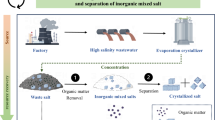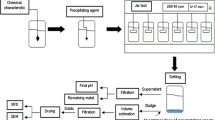Abstract
Iron ore tailings are industrial solid wastes generated from mineral processing. The disposal of iron ore tailings leads to environmental threat and serious security because of their tiny particle size and large storage. In this paper, suspension magnetization roasting and magnetic separation technology were utilized to recover iron tailings. The results showed that iron concentrates with iron grade of 65.01% and recovery of 89.07% could be obtained under conditions of CO concentration 30%, roasting temperature 520 °C, roasting time 20 min, grinding particle size of roasted products with 94% mass fraction of − 38 μm and magnetic field strength 1800 Oe. The vibration sample magnetometer, X-ray diffraction, specific surface area detector, scanning electron microscope and energy-dispersive spectrometer showed that unit mass magnetic moment, specific magnetization coefficient and saturation value of magnetization intensity of magnetic concentrate were all significantly improved. Weak magnetic iron ore was selectively transformed into strong magnetic magnetite. Compared with raw ore, there was porous and cracked structure on the surface of roasted ore and magnetic concentrate, which was conducive to magnetization reaction, magnetism and phase transformation of iron ore.


















Similar content being viewed by others
References
Yuan CJ, Li HQ, Jia XP, Li Q (2015) Improving resource utilization efficiency in China’s mineral resource-based cities: a case study of Chengde, Hebei province. Resour Conserv Recycl 94:1–10
Ali US, Mohd WH, Yusof A, Jahangir M (2016) Evaluation of iron ore tailings as replacement for fine aggregate in Concrete. Constr Build Mater 120:72–79
Schenk JL (2011) Recent status of fluidized bed technologies for producing iron input materials for steelmaking. Particuology 9(1):14–23
Binnemans K, Jones PT, Blanpain B, Van Gerven T, Pontikes Y (2015) Towards zero-waste valorisation of rare-earth-containing industrial process residues: a critical review. J Clean Prod 99:17–38
Yang HF, Jing LL, Zhang BG (2011) Recovery of iron from vanadium tailings with coal-based direct reduction followed by magnetic separation. J Hazard Mater 185:1405–1411
Giri SK, Das NN, Pradhan GC (2011) Synthesis and characterization of magnetite nanoparticles using waste iron ore tailings for adsorptive removal of dyes from aqueous solution. Colloid Surf A 389:43–49
Yellishetty M, Karpe V, Reddy EH, Subhash KN, Ranjith PG (2008) Reuse of iron ore mineral wastes in civil engineering constructions: a case study. Resour Conserv Recycl 52:1283–1289
Suthers SP, Nunna V, Tripathi A, Douglas J, Hapugoda S (2014) Experimental study on the beneficiation of low-grade iron ore fines using hydrocyclone desliming, reduction roasting and magnetic separation. Miner Process Extr Metall 123:212–227
Zheng YX, Lv JF, Lai ZN, Lan ZY, Wang H (2019) Innovative methodology for separating copper and iron from Fe–Cu alloy residues by selective oxidation smelting. J Clean Prod 231:110–120
Halim KSA (2007) Isothermal reduction behavior of Fe2O3/MnO composite materials with solid carbon. Mater Sci Eng A 452–453:15–22
Cheng Z, Zhu GC, Zhao YN (2009) Study in reduction-roast leaching manganese from low-grade manganese dioxide ores using cornstalk as reductant. Hydrometallurgy 96:176–179
Borra CR, Blanpain B, Pontikes Y, Binnemans K, Van Gerven T (2016) Recovery of rare earths and other valuable metals from bauxite residue (Red mud): a review. J Sustain Metall 2(4):365–386
Wang XP, Sun TC, Wu SC (2019) A novel utilization of Bayer red mud through co-reduction with a limonitic laterite ore to prepare ferronickel. J Clean Prod 216:33–41
Khairul MA, Zanganeh J, Moghtaderi B (2019) The composition, recycling and utilisation of Bayer red mud. Resour Conserv Recycl 141:483–498
Keith Q (2018) A review on the characterisation and processing of oolitic iron ores. Miner Eng 126:89–100
Yuan S, Zhou WT, Han YX, Li YJ (2019) Selective enrichment of iron from fine-grained complex limonite using suspension magnetization roasting followed by magnetic separation. Sep Sci Technol. https://doi.org/10.1080/01496395.2019.1677715
Li H, Kwauk M (2013) Review and prospect of fluidization science and technology. Chin J Chem Eng 64:52–61
Jeongseog O, Dongsoon N (2017) The reduction kinetics of hematite particles in H2 and CO atmospheres. Fuel 196:144–153
Srinivasan N (2002) Reduction of iron oxides by carbon in a circulating fluidized bed reactor. Powder Technol 124:28–39
Plaul FJ, Bohm C, Schenk JL (2009) Fluidized-bed technology for the production of iron products for steelmaking. J S Afr Inst Min Metall 108:121–128
Fryda LE, Panopoulos KD, Kakaras E (2008) Agglomeration in fluidised bed gasification of biomass. Powder Technol 181:307–320
Yuan S, Zhou WT, Han YX, Li YJ (2020) Efficient enrichment of low grade refractory rhodochrosite by preconcentration-neutral suspension roasting-magnetic separation process. Powder Technol 361:529–539
Nie YM, Chen M, Niu FS (2013) Separation of weak magnetic iron ore with micro-fine particle. Appl Mech Mater 389:349–351
Acknowledgements
This work was financially supported by the National Natural Science Foundation of China (Grant Nos. 51904058; 51734005), Open Foundation of State Key Laboratory of Mineral Processing (Grant No. BGRIMM-KJSKL-2020-17).
Author information
Authors and Affiliations
Corresponding author
Additional information
Publisher's Note
Springer Nature remains neutral with regard to jurisdictional claims in published maps and institutional affiliations.
Rights and permissions
About this article
Cite this article
Yuan, S., Zhou, W., Han, Y. et al. Efficient enrichment of iron concentrate from iron tailings via suspension magnetization roasting and magnetic separation. J Mater Cycles Waste Manag 22, 1152–1162 (2020). https://doi.org/10.1007/s10163-020-01009-2
Received:
Accepted:
Published:
Issue Date:
DOI: https://doi.org/10.1007/s10163-020-01009-2




